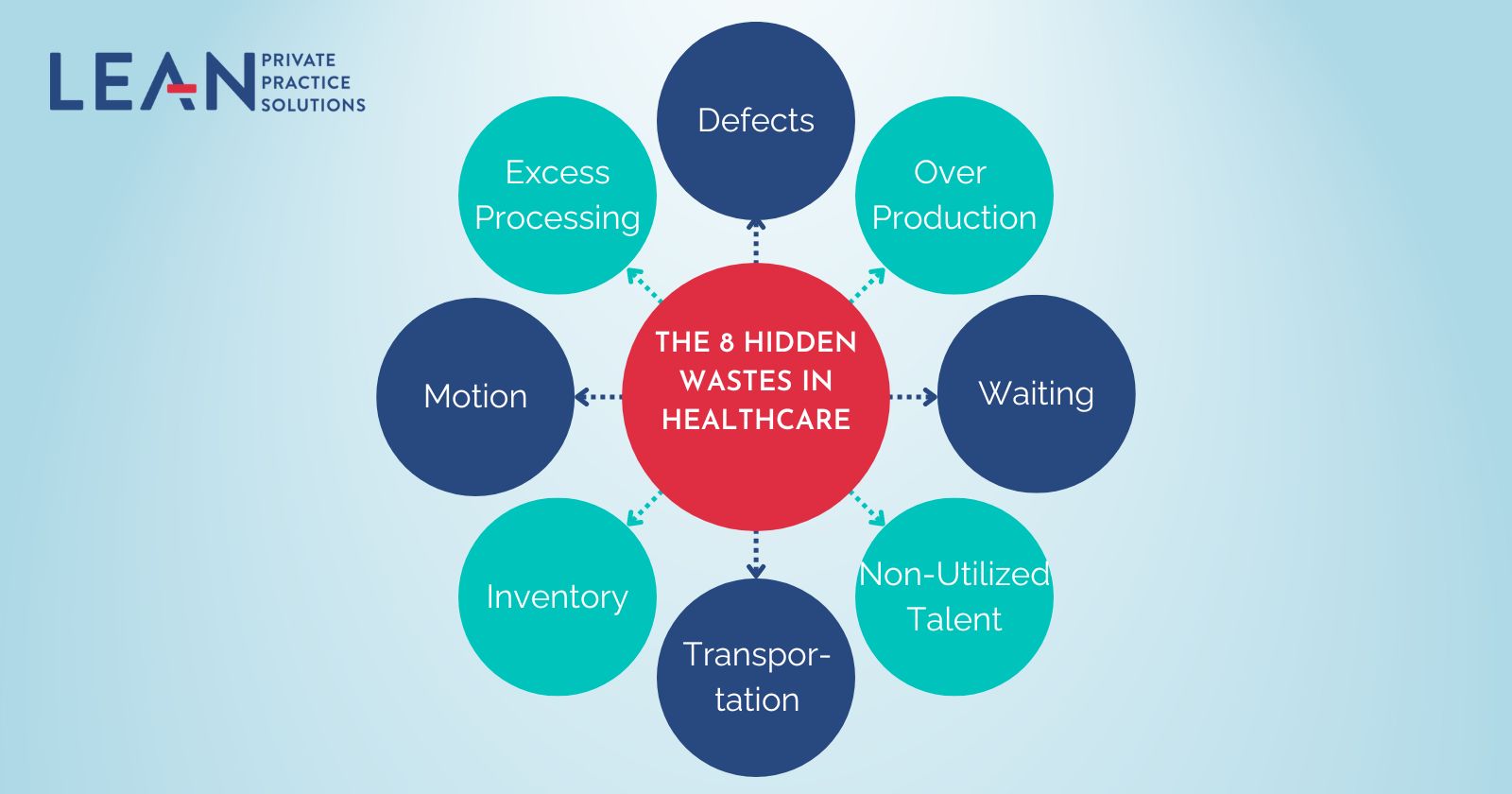Last week we went over the 8 Hidden Wastes in Healthcare, as identified by lean principles. Now let us see how we can eliminate those rampant wastes in our healthcare systems.
Different wastes show up in different degrees in different kinds of setups: but if you look around, you will identify many of these in own practices. So, here we go down the list:
#1: Reduce Over-processing
Take a look at the processes that give you information about your patients and see if any of them are redundant. Instead of asking patients to give us that information again, can we glean it from where it already exists?
If your electronic medical records and practice management/billing system do not talk to each other, that divorce is imminent! Find a system or a pair of systems can that can get along, ie., be integrated.
#2: Reduce Overproduction
This one’s easy. Get only as much as you need. Of anything.
#4: Reduce Excess inventory
In much the same way as decreasing overproduction, reducing inventory is about not ordering humungous amounts of stuff. Unless you get a sizable discount for bulk ordering, figure out how much stuff you need within a reasonable time frame, like one to two quarters, and go from there.
Keep an eye on the inventory to make sure you don’t run out and have to lose out on business or delay procedures.
When it comes to the technology stack, stay updated. I think one of the best ways of going lean in private practice is to use the latest tech advances to our benefit.
- *Cloud-based EMR
- *Modern built-in malware
- *AI-based scribes
- *Virtual assistants
All the above and new options every day help us be more efficient, while also being more affordable than human labor. This can help with staffing issues, which is fairly ubiquitous among healthcare setups of all sizes.
#5: Reducing Wasted motion
So many things we can do about this!
When you’re in the office, and have two or three exam rooms assigned to you to see patients in, make sure they’re close to each other- preferably next to each other. That will help you and your MA throughout the day as you go room to room seeing patients.
Figure out the path that most of your patients in the office take. Starting with the waiting room, check-in desk, exam room, phlebotomy/lab/radiology room, check-out desk… make this as patient-friendly as possible- with the least amount of backtracking and avoiding bottlenecks.
Place stuff where they are needed most. Like supplies needed for procedures should be in the procedure room or very close to it. Like the scanner or copay machine should be where it most often used: like at the front desk.
Then there is the issue of how team members work together. It helps to have work pods for every physician-MA duo. That way they’re not constantly walking over to each other or interrupting the other’s workflow with calls or messages.
It is also very useful to have information centralized. That way, everyone has access to the information and work is not interrupted or slowed down due to lack of information.
#6: Reducing Waiting/idle time
This is already high on everyone’s priority list because timely access to healthcare is important and very more difficult to achieve.
Every practice will have to find its own solution to the problem of access by either hiring more resources or utilizing resources better.
No one should need a big waiting room- unless there are multiple physicians seeing patients in the office at the same time. Each physician should have, at the most, two or three patients waiting for them at any given time.
A large number of patients waiting ruffles everyone up and adds to the stress of a busy clinic day.
On that note, it also helps to have no more than two (max three) exam rooms per physician for a particular clinic day. Otherwise the exam rooms just serve as additional waiting rooms!
#7: Reducing Errors/Defects
This is so important- because errors in medicine cost lives.
But errors happen in all aspects of our practices- from the demographic information entered by front desk staff all the way to billing.
And even if all errors do not cost lives, they usually cost $$$.
Run through every process in your practice and automate/integrate anything that you can. The more the human touch, the more the chance of error.
Also, simplify processes. This make the job easier and therefore a less skilled worker can do it and reduces the chance of error. It also costs less to have a simpler process and hire a less skilled worker.
Be meticulous with your Standard Operating Procedures (SOPs). These are pain to build out initially but once done, they’re done- and only need small tweaks as you go along.
I did not have SOPs for a long time since I started as a micro practice and all the SOPs were in my head! So when I finally had to write them all out when I hired my first virtual assistant, I nearly tore my hair out. However, it helped tremendously to train my next hire and at this point, cannot imagine not having those policies and procedures to guide us daily.
#8: Reducing Unused talent
All progress is a result of human ingenuity. So any waste of human talent is such a shame. Fortunately, just having this on our radar helps us utilize all the talent we have access to, better. Automation and technology helps. And systemic changes will help big time- but that is a bigger battle.
Give your staff increasing responsibility with adequate training and oversight- and watch them thrive. It builds a positive office culture that often retains people better than money.
Well, these are some ways we can reduce some of the waste that is so rampant in our practices- thereby becoming more sustainable and profitable in the process. Which of will you implement in your practice first?




